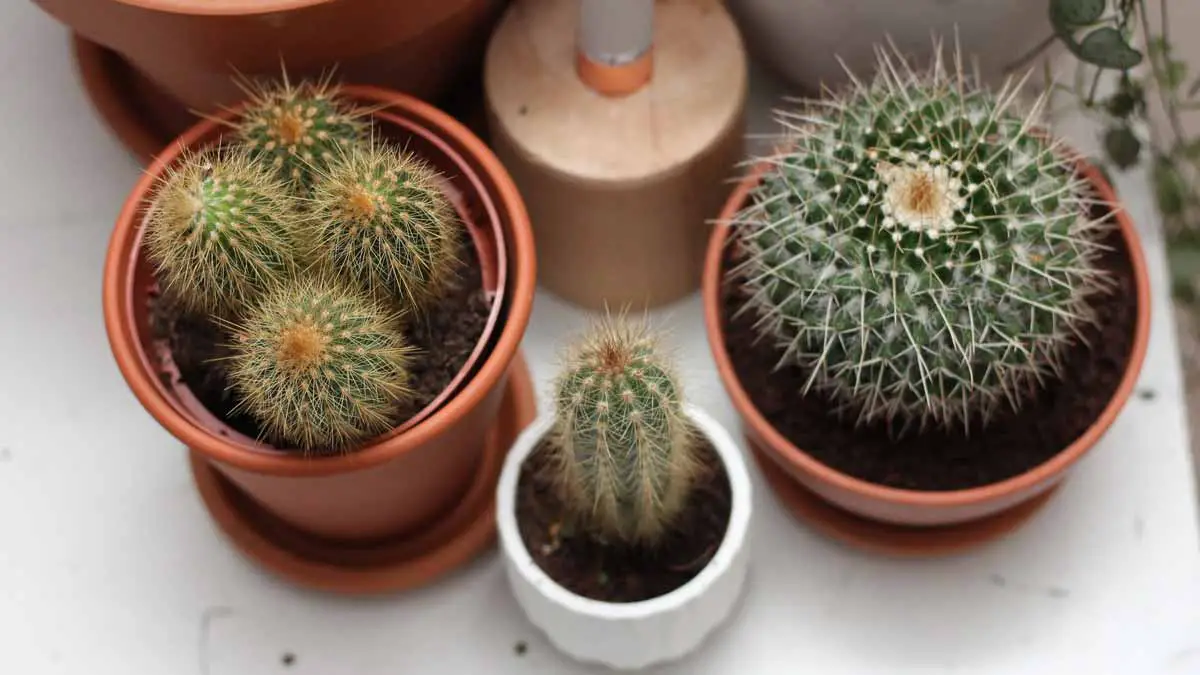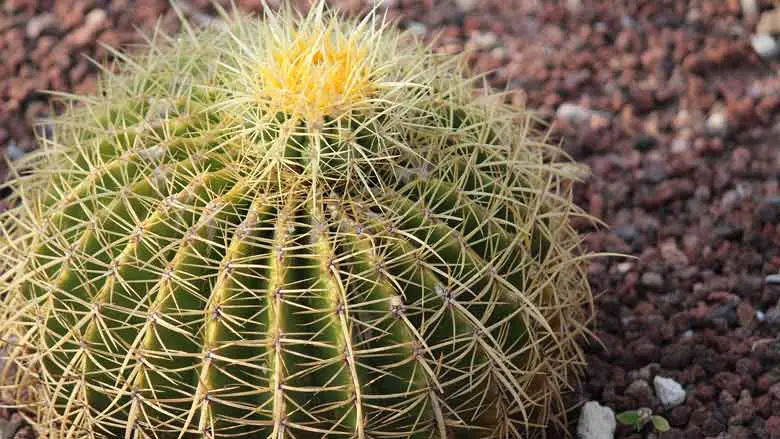Do you have a cactus that is growing too large for its pot?
Or maybe you want to move your cactus to a new location in your garden.
No matter the reason, transplanting a cactus can be an easy process if you follow these simple steps!
In this article, we will walk you through the entire process of how to transplant a cactus successfully.
Things to Consider Before Transplanting a Cactus
Before transplanting your cactus, there are a few things you need to take into consideration.
Is It the Right Time to Transplant Your Cactus?
Cacti do not like being disturbed and prefer to be left alone.
The best time to transplant a cactus is during its growing season, which will be in early spring or summer.
Avoid transplanting a cactus during the fall or winter when the plant is dormant.
Is Your Cactus Healthy?
Transplanting a sick or dying cactus will only make matters worse and may kill the plant.
If your cactus plant has not been doing well, wait until it is healthy and strong before attempting to transplant it.
A healthy cactus will have firm, green pads with no signs of rot or softness.
Also, make sure that the plant has enough roots to support itself in its new home.
You can check this by gently removing a few of the cactus’ roots and inspecting them for signs of damage or decay.
If your cactus does not have enough healthy roots, you may need to wait until it is stronger before transplanting.
How Big Is Your Cactus?
If your cactus is too large, it may be tough to transplant.
Weigh the pros and cons of moving a large cactus before you decide to do so.
A small or medium-sized plant will be much easier to handle during transplanting than a larger one.
What Type of Soil Will You Use?
The type of soil you use for your cactus is essential.
Cacti prefer a loose, sandy soil that drains well.
If you are transplanting your cactus into a pot, make sure to use a potting mix that is specifically designed for cacti.
If you are planting your cactus in the ground, make sure to use a soil that drains well and is not too rich or dense.
The best way to do this is by adding sand or perlite to the soil before transplanting.
What Type of Pot Will You Use?
If you are transplanting a cactus into a pot, make sure that the container is not too large for the plant.
A good rule of thumb is to choose a pot that will allow room for the roots but does not have more than an inch or two extra space around them in all directions.
Also, when choosing a pot for your cactus, it’s better to use unglazed clay pots over plastic or metal pots.
Unglazed clay pots allow the pot to breathe and help keep your cactus healthy.
These pots allow the soil to dry out more quickly, which is important when growing a cactus indoors and can prevent root rot from occurring if you water too often.
The pot should also have drainage holes, so that excess water drains away from the roots of your plant!
How to Transplant a Cactus Into a Pot: A Step-by-Step Guide

If you follow these simple steps, transplanting a cactus into a pot is an easy process!
1. Gather Your Materials
To get started, gather all of the materials that you will need for transplanting.
The basic materials you will need are:
- A pot or container for the cactus
- Potting mix specifically made for cacti
- Protecting gloves
- Newspaper
- A trowel or shovel
2. Prepare Your Pot and Soil
Before transplanting your cactus, you must prepare the pot and soil.
If you are using a new pot, make sure to wash it well with hot water to remove any residues or toxins.
Make sure that there are drainage holes in the bottom of your pot so that excess water can drain away from your plant’s roots.
You can also place a layer of stones or clay pellets at the bottom of your pot. This will help keep the soil from becoming too wet and prevent root rot.
Next, add soil to your pot. Use a cactus potting mix or make your own. A good cactus soil mix is made with equal parts of potting soil, coarse sand, and perlite.
Add soil to your pot until it is about two-thirds full. Be sure to leave enough space for the roots of your cactus.
3. Remove Your Cactus From Its Old Pot
Now that your new pot is ready, you can start to remove your cactus from its old one.
You need to loosen the soil around the cactus and then gently pull it out of its old pot.
If you are having trouble with this step, you may need to use a knife or other tool to help loosen the soil around your plant’s roots before pulling it out.
Gently pull the cactus out of its old pot, taking care not to damage the roots.
If your cactus is too large to move by hand, you can use a trowel or shovel to help you get it out of its old pot.
Be careful not to damage the roots when doing this!
If you are transplanting a large cactus, make sure to wear protective gloves while doing this step to avoid getting poked by spines on its body or leaves.
4. Loosen and Remove the Soil Around the Cactus Roots
Once your cactus is out of its old pot, you will need to loosen and remove the soil from around its roots.
Do this by gently shaking or tapping the potting mix around the roots. This will help loosen the old soil and make it easier to transplant.
If the roots are very tightly packed, you can use a trowel or your hands to loosen them up.
Once most of the soil has been removed from the roots, use your hands to brush away any excess soil gently.
This will help you see the roots better and prepare for the next step of transplanting.
5. Trim the Damaged or Dead Roots
Once the soil has been removed from the roots of your cactus, you will need to trim any damaged or dead roots.
You can do this using a pair of garden shears or scissors.
Try to cut away only the damaged roots and avoid cutting any healthy ones if possible!
It is normal for some roots to be brown, so don’t worry about these unless they look mushy or blackened on one end.
If you are unsure which roots need to be trimmed, it’s better to leave them alone than trim too much.
The cactus root system will regenerate over time with proper care.
6. Place the Cactus in the New Pot
Now that the roots have been trimmed, it’s time to place your cactus in the new pot.
If you are using a container other than a pot, like a bucket or a tray, make sure that it has drainage holes so excess water can escape.
Place your cactus in the center of the pot or container.
You can use a towel or newspaper to protect your hands from getting scratched by the spines on its body or leaves.
If you are transplanting a large cactus, be sure to spread out its roots so that they don’t bunch up in one area.
Once it is in place, fill in around the roots with soil mix until the pot is full.
Pack down the soil gently but firmly to help hold your cactus in place.
You can also add some pebbles or gravel to the top of the soil for aesthetic reasons if desired.
7. Don’t Water the Cactus Just Yet!
It’s important not to water your cactus immediately after transplanting.
Allow it to sit for a few days and let the roots become established before watering again.
This will help reduce shock in addition to giving them time to adjust.
After three or four days, you can water your cactus again as usual.
Be careful not to overwater it!
If you are unsure how much water to give your cactus, it’s best to wait until the soil dries out before watering again.
How to Transplant a Cactus in the Ground: A Step-by-Step Guide

If you have a cactus that is too big for its pot, or if the pot it’s in has become root-bound, you will need to transplant it into the ground.
To do this, follow these steps to do so safely and efficiently:
1. Choose a Location for Your Cactus
The first thing you will need to do is choose where your cactus will be planted.
When picking out a spot, make sure that there is plenty of sunlight, and it’s in an area with good drainage so water doesn’t collect around its roots (which can cause them to rot).
It’s also important to consider how much space your cactus will need once it grows larger.
If you are transplanting a large cactus, be sure to leave enough room for it to grow!
2. Prepare the Ground for Transplanting
Before you start digging up your cactus, it’s a good idea to prepare the ground where it will be planted.
This will help reduce shock and make transplanting easier overall. To do this, follow these steps:
Dig a hole that is twice as wide as the diameter of your cactus and about the same depth.
Use a shovel to loosen up the soil around it and break any large clumps of dirt that may be present.
If you transplant a cactus into an area with very sandy or clay-like soil, add some compost or other organic matter before putting your plant in place.
This will help improve drainage while also providing your cactus with some nutrients it may need.
3. Dig Up Your Cactus
After you have prepared a hole for your cactus to be planted in, it’s time to dig up the plant.
Use a shovel to dig around the base of your cactus about six inches away from its trunk. This will help ensure that none of the roots are damaged during removal.
Once you have dug all the way around it and there is enough space between them, gently pull on your cactus to remove it from the ground.
If you are having trouble getting it out, use a hoe or other gardening tool to loosen up any roots that may be holding onto the soil.
Be careful not to damage the roots when doing this!
If your cactus is large, you may need help from a friend or family member to get it out of the ground.
Once you have removed your cactus from the ground, place it on a flat surface so that its roots don’t get damaged while being transported.
You can use a tarp or blanket to keep them protected while moving.
4. Trim any Damaged or Dead Roots
Before you transplant your cactus, take a look at its roots and trim any that are damaged or dead.
This will help reduce the chances of your cactus getting sick after being transplanted.
If there are any large chunks of dirt still attached to the roots, be sure to remove them as well.
Do not trim any healthy roots!
Once you have trimmed the dead or damaged roots, it’s time to place your cactus in its new home.
5. Plant Your Cactus in the New Location
Once you have removed your cactus from the ground, it’s time to plant it in its new home.
Carefully lower your cactus down into the hole you dug and make sure that it stands upright before backfilling with dirt around all sides of the plant.
If you are transplanting a large cactus, make sure its roots are spread out not to get twisted or bunched up.
Once you have filled in the hole, use a garden hose to lightly water the area around your cactus. This will help settle the soil around its roots.
Wait a few days before watering your cactus again to give it time to adjust to its new home.
After you have transplanted your cactus, it’s important to keep an eye on it for the next few weeks.
This will help you make sure that it is adapting well to its new environment and isn’t showing any signs of stress.
How to Transplant a Cactus Without Getting Poked
When transplanting a cactus, there is always the risk of getting poked by its needles.
Here are a few tips on how to avoid this:
- Wear gloves when handling your cactus. This will help protect your hands from any sharp needles. The best gloves to use are those made from nitrile or latex.
- Wear long pants and a shirt with sleeves that cover your wrists. This will help protect your arms and legs from needles.
- Use tools such as shovels, rakes, and hoes to help you dig up soil around your cactus. This will allow you to keep your hands away from its needles while digging.
- Use tongs or tweezers when handling small cacti. This will help prevent you from getting poked by its needles while holding it.
- When moving it, use a towel or other cloth to wrap around your cactus. Also, make sure to place it in a safe area where people and pets won’t be able to step on it.
- If you are transplanting a large cactus, have someone help you. This will reduce the chances of you getting poked while trying to move it.
You can transplant your cactus without getting poked by its needles if you follow these tips!
Final Thoughts
Cactus plants are pretty easy to transplant.
But you have to make sure that they are healthy enough before transplanting. So check the stems, roots, and soil for any signs of disease or damage.
Once your cactus is ready to be transplanted, the process will take only a few minutes.
Cacti are easy to care for, but they are not invincible. So follow the tips we included to ensure that your cactus survives and thrives after transplanting.







